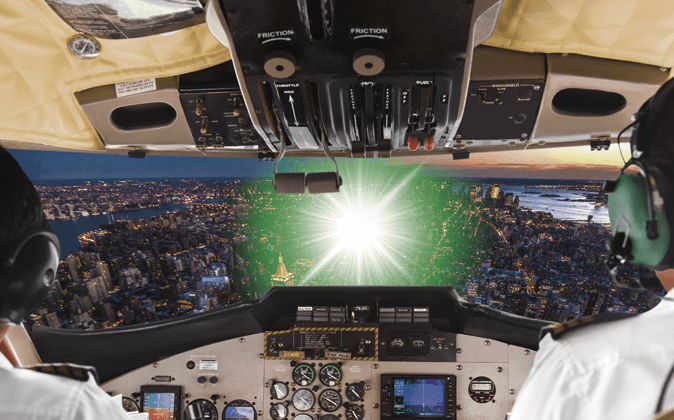Robert Hamilton gazed at the warm web of yellow lights stretching over Charlotte, N.C., as he steered his commercial jet to descend to the airport.
Suddenly, a shocking green light flooded the cockpit.
“I was experiencing flash blindness all of a sudden,” said Robert Hamilton, a North Carolina-based pilot who frequently flies to New York. He was flying a 70-seat passenger plane at the time.
Hamilton was startled by the bright light and felt nervous. Vision is critical for a pilot. He feared that the damage was permanent and wondered if he would ever fly again.
“In a split second, my vision’s gone,” Hamilton said. The laser light dissipated as instantly as it hit the aircraft, but Hamilton experienced after-imaging for the next couple of hours. “Fortunately, I was able to land safely.”
Hamilton had lasers hit his aircraft five times over the past nine years.
Pilot Injuries
“Laser incidents are often viewed as harmless. This couldn’t be further from the truth,” FBI Assistant Director in Charge George Venizelos stated in a press release.
Less than a month ago, a Delta pilot landing in LaGuardia Airport reported a green laser beam. Two pilots on that flight were injured and experienced flash blindness. In January, a United Airlines pilot landing at LaGuardia experienced irritation for several days after a laser hit his cockpit. A JetBlue pilot landing at John F. Kennedy Airport experienced blurry vision for over a week after being hit with a laser in December.
The FBI is seeking information for these recent cases and offering a $10,000 reward for information leading to arrests.
“Imagine driving down the road, and all of a sudden all of your windows are bright green,” said Mike Karn, president of the Coalition of Airline Pilots. “I’ve had guys out for two or three weeks. The doctor said, ‘It looks like someone just ran over your eyes with sandpaper.’”
Two pilots who Karn spoke to were unable to fly for a month. Another described it as being “punched in the eye.” A colleague of Hamilton’s had to get his corneas treated because the damage was so severe. The immediate impulse is to rub your eyes, but that only makes it worse.
No reported cases have caused permanent damage however, according to 2011 data from the Federal Aviation Administration.
But the anxiety pilots feel after the attacks is much greater than temporary vision impairment, according to aeromedical adviser Quay Snyder.
Laser Pointers
The lasers in question are simple laser pointers one can buy online for roughly $40. They are commonly used to circle constellations in the sky and for laser shows.
The lasers are visible—and dangerous—to pilots around 4,000 feet in the air. Helicopter pilots, who fly at lower altitudes, are at higher risk than jet pilots.
Green lasers pose more danger than the red or blue lasers even if the wattage is the same, because the green ones will appear brighter and thus blinding.
Laser laws vary by city or state. In New York City, it is illegal to sell or give a laser pointer to a person under the age of 18, and illegal for anyone under 20 to possess a laser pointer on school grounds.
Nationally, pointing a laser at an aircraft is illegal. In 2012, the offense was upgraded to a felony.
Frequency and Awareness
Hamilton first experienced a laser event nine years ago, and there was much information on what to do in these cases. He followed the emergency protocol and kept his head down, immediately warning his first officer of the laser event.
The FAA started recording reports of laser incidents in 2005. In 2006 there were 384 reported laser events. In 2013, the number shot up to 3,960, or nearly 11 incidents a day.
The increase is due to both the increased accessibility of lasers, and increased awareness among pilots as to what to do in such an event.
“This used to happen once in a blue moon,” said Tony Byrnes, who has been flying a law enforcement helicopter for over 30 years in Hawthorne, Calif., a city close to the Los Angeles International Airport.
In the last few years, incident reports rose to at least once or twice a year from the passenger jet pilots, Byrnes said.
It often seems obvious the person holding a laser is aiming at an aircraft, said Byrnes, a board member of the Professional Helicopter Pilots Association. The beams chase after and try to stay on the aircraft, which “is not as easy at it sounds,” but those who aren’t too bright keep trying and are easily arrested, Byrnes said.
Helicopters fly at altitudes around 500–700 feet, and at that level the beams are pretty dispersed. Byrnes said helicopter pilots will usually see the beam on one side, and the beams won’t illuminate the whole cockpit. The law enforcement pilot is supposed to turn away from the beam, then fly toward the source and apprehend the person if possible. If there are multiple incidents in a night, they will send policemen on the ground to the area.
Intention
The federal government allowed the FAA to take enforcement action in laser events as of 2011. The FAA has continually pushed for higher penalties since.
Last month, a California court sentenced a 26-year-old man to a 14-year sentence for pointing a laser at an aircraft, the longest sentence in the history of laser incident convictions. He had been using a laser 13 times more powerful than the legal limit and his actions were deliberate. His girlfriend had been convicted for the same crime just months before.
It is unlikely someone could unknowingly point a laser at an aircraft, Karn said. But not everyone understands how dangerous it is.
“I’ll give a public apology to the pilot,” Justin Stouder told the FBI after he was shown the effects of pointing a laser at a pilot in an FBI video. He had pointed a laser at a passing helicopter in St. Louis and was quickly arrested. “I had no idea it illuminated the whole cockpit and blinded everybody inside.”
Arrests have increased with the frequency of events in the past few years, including someone as young as 14 years old.
According to an FBI spokeswoman, there have been 82 prosecutions with 77 convictions since 2004.
“Malicious intent was found in roughly three-quarters of those cases,” the spokeswoman said. Malicious intent is not separated from any other intent under the statute in which these people are prosecuted.
Not many of the people convicted are repeat offenders, and many are never apprehended.
Hamilton said he never found out if any of the people pointing lasers at his aircraft were arrested, but he doubts the majority understand the severity of pointing a laser at a pilot.
“If you knowingly caused an accident, endangered people’s lives—I can’t imagine anyone having that on their conscience,” Hamilton said.
Cooperation
Karn said the missing link is cooperation between pilots, Air Traffic Control (ATC), and law enforcement.
Pilots currently report every incident by giving ATC the aircraft’s location and what direction the laser event came from if they know, but occasions where the violator is apprehended are slim compared to the nearly 4,000 events a year.
Canada, by comparison, reports nearly one-tenth of the laser incidents of the United States. Pilots send their location information to ATC with the press of a button, which allows law enforcement to immediately search the area for someone shining a laser.
Otherwise, it’s like “looking for a needle in a haystack,” Karn said.






Friends Read Free